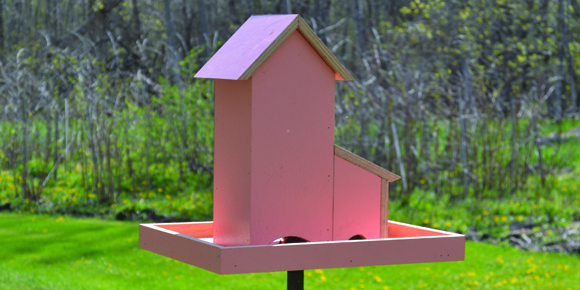This is the time of year to build a bird feeder to attract finches, woodpeckers, orioles and other colourful members of the avian family that return from southern climes to nest in the Great White North.
The feeder I constructed is made of scrap half-inch plywood and is designed to look like a prairie grain elevator.
Tools and materials required: table saw, jig saw, pneumatic/electric brad nailer or hammer, No. 2 and No. 3 Robertson screw drivers or bits, about 10 square feet of half-inch exterior plywood, pair small brass hinges, one-inch OD steel pipe with one threaded end, 3 1/4-inch diameter steel pipe flange, No. 6 coated deck screws, No. 12 steel screws, finishing nails, waterproof glue, stain or paint.
• Set the table saw to 45-degrees and rip four pieces of plywood 5 1/2-inches wide by 14-inches long.
• Cut out 1/2-pitch roof peaks on two pieces of ripped material with a table or jig saw. Bevel other two side pieces with the saw to conform to pitch of roof peak.
• Assemble four sides of the elevator using waterproof and brad nailer or hammer and one-inch finishing nails. If working alone, the brad nailer will expedite the process, as will a wood vise.
• When the glue has set, use a jig saw to cut out arched-holes at the bottom of the front and back sides to allow bird seed to flow out of elevator onto the feeder’s tray.
• Rip enough plywood at 45-degrees on two sides to make two roof decks a half-inch wider all around than elevator box. The pieces should meet snuggly at the peak and look like fascia boards at the edges.
• Nail and glue one roof deck firmly in place. The opposite deck is held in position by two brass hinges, allowing the deck to open for filling the feeder with seed.
• Cut a hole with a jig saw in the side of the elevator to which the shed will be attached. The hole will allow the shed to fill with seed when the feeder is filled.
• Build the shed in a similar manner to the elevator. The shed requires only three sides and a roof deck. (I didn’t bevel the sides of my shed. In retrospect, I should have as the overall feeder would be more attractive with all of the corners bevelled. However, a couple of coats of paint will mostly hide this visual distraction.
• Before attaching the shed to the side of the elevator, cut or drill arches at the bottom of each front and back piece to correspond with those previously cut in the elevator. Working from inside the elevator, fasten the shed with brads or nails to the outside of the elevator.
• Rip a 12-by-12-inch plywood tray and attach 1 1/2-inch wide plywood sides with mitred corners to the outside edges of the tray with nails/brads and glue.
• Centre the completed feeder on the tray and screw it to the tray from the underside with 1 1/4-inch No. 6 coated deck screws. To prevent cracking the edges of the plywood sides of the feeder, drill small pilot holes first.
• Turn the feeder on its side and centre the pipe flange on the bottom of the tray by drawing diagonals from corner to corner. Secure the flange to the tray’s bottom with No. 12 Robertson wood screws (usually four are required).
• Screw the one-inch OD length of steel pipe into the female end of the flange. The length of the pipe depends on how high you want it to sit above the ground. For easy filling, not more than six feet from ground to peak is optimal. Alternatively, you can skip the pipe by placing the feeder on a deck or securing it to a deck’s railing.
• Squirrels can climb up iron pipe. One method to keep them out of your feeder is to fasten a slinky to the bottom of the feeder’s tray, the coils surrounding the flange and pipe. It’s frustrating for the squirrels, but quite amusing for us humans to watch the little rodents grab onto the slinky with their claws and suddenly take an unexpected downward trip to the ground. They soon tire of the game. You can still buy a slinky at most dollar or toy stores.
may my heart always be open
to little
birds who are the secrets of
living
whatever they sing is better
than to know
and if men should not
hear them men are
old
— e.e. cummings



